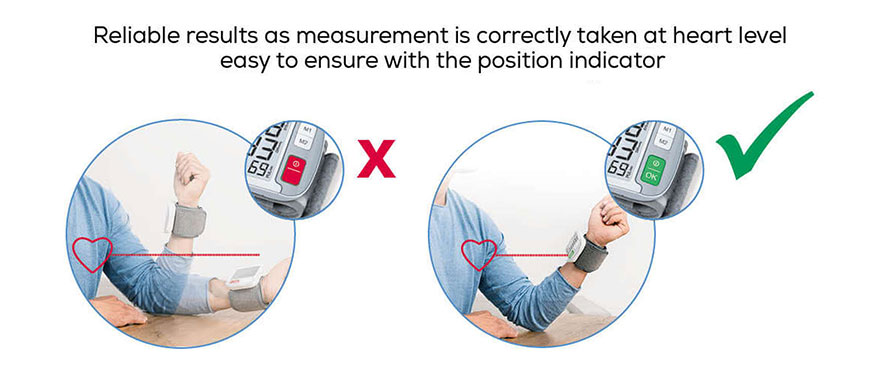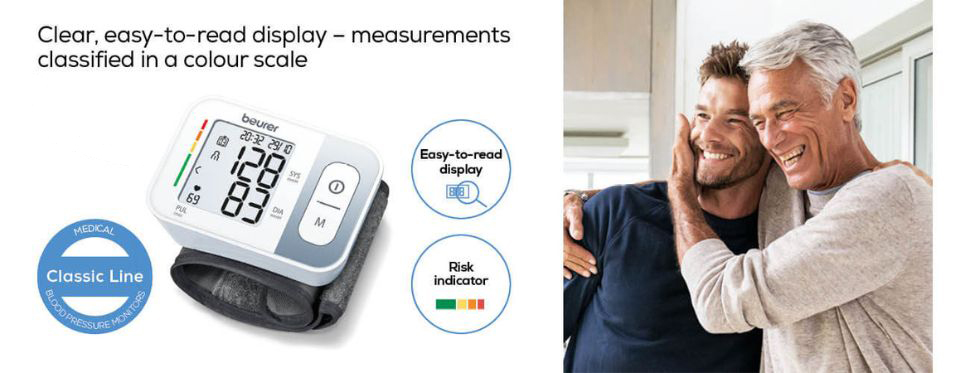How Accurate are Wrist Blood Pressure Monitors?
Aug 07, 2023There’s a dilemma that you face with wrist blood pressure monitors. And it all comes down to one thing – Are they reliable? The answer is yes. Wrist blood pressure monitors are a valuable tool. It could be life-saving too. Having one at home can encourage regular monitoring of blood pressure and better health management. Not just for you, but your family, elderly parents, or children also.
What is Blood Pressure and Why is Measuring BP Important?
A good place to start is to get to know your body. Did you know that measuring blood pressure plays a vital role in maintaining health and preventing fatal heart diseases? Blood pressure is the core of what could lead to a stroke, hypertension, coronary diseases, heart failure, and even kidney diseases. Hence, regular monitoring – even at home – is essential to enable different lifestyle choices.
Blood pressure is the force at which your blood is pushed against the walls of your arteries as it circulates through the body. In simpler words – It is to measure the pressure at which blood flows in your body. If you have ever used a wrist blood pressure monitor, you would have seen "mmHg" on it. Blood pressure is measured in millimeters of mercury to give you two values:
- Systolic pressure is when your heart beats. It is the maximum pressure in the arteries when the heart beats and pumps blood into the circulation. This split second provides oxygen and nutrients to various tissues and organs.
- Diastolic pressure represents when your heart is at rest. It shows the minimum pressure. When the heart rests for a split second the heart's ventricles relax and fill with blood.
How Do Wrist Blood Pressure Monitors Work?
Wrist blood pressure monitor is a small and portable device to measure your blood pressure from your wrist. It picks up on the radial artery – which is closer to the skin of your wrist – to help you find out your BP at home. Wrist blood pressure monitors are for those who think the upper arm blood pressure monitors are complicated to use.
These monitors come with a cuff that inflates around the wrist and restricts blood flow to the radial artery. The sensor in the cuff measures the changes in the flow as the cuff deflates. That is how the BP is calculated in numbers.

What's Normal and What's not?
When you use wrist blood pressure monitors, the reading will come up as ratio of systolic pressure over diastolic pressure. Systolic pressure is shown first, then diastolic pressure. Normal BP is 120/80 mmHg or lower. But not too low! Higher blood pressure means risks of hypertension and lower blood pressure means risks of hypotension.
One high blood pressure reading does not mean you have hypertension. It is normal for your blood pressure to fluctuate due to exercise, food intake, stress, or anxiety. Just like that, one low BP reading does not mean you have hypotension.
Hypotension can mean feeling dizziness, fatigue, dehydration, or fainting. Hypertension is mostly referred to as a "silent killer" because there are no noticeable symptoms. Until it gets bad. This is why regular monitoring is encouraged among all ages. Hypertension looks like having headache, dizziness, blurred visions, and shortness of breath, nosebleeds, or chest pain.
As per the American Heart Association (AHA), here's how you can know what's not normal:
Elevated Blood Pressure:
- Systolic Pressure: 120-129 mmHg
- Diastolic Pressure: Less than 80 mmHg
Hypertension Stage 1 (Mild Hypertension):
- Systolic Pressure: 130-139 mmHg
- Diastolic Pressure: 80-89 mmHg
Hypertension Stage 2 (Moderate Hypertension):
- Systolic Pressure: 140 mmHg or higher
- Diastolic Pressure: 90 mmHg or higher
Hypertensive Crisis (Emergency):
- Systolic Pressure: Higher than 180 mmHg
- Diastolic Pressure: Higher than 120 mmHg
Is Taking Your Blood Pressure From Your Wrist Accurate?
It's the question of the hour. Yes, wrist blood pressure monitors are accurate. But, only if you do it correctly. Anyone who wants to use it to track blood pressure trends at home wrist monitors are your way to go. Though, it is said that a traditional arm blood pressure monitor will give you the most accurate reading. But here's why you may see a slight difference between wrist blood pressure monitors and a traditional one:
- The radial artery in your wrist is smaller than the one in your upper arm, which is known as the brachial artery.
- Your body has to be a specific position for an accurate reading. You have to be sitting down or lying with your arm at heart level.
How Much Higher Do Wrist Blood Pressure Monitors Read?
Wrist blood pressure monitors usually deliver higher readings than arm blood pressure monitors. As per a study, wrist blood pressure monitors read 5.5 mmHg higher systolic blood pressure. It can show a 2.3 mmHg higher diastolic blood pressure than arm blood pressure monitors.
Why Do Wrist Blood Pressure Monitors Read Higher?
Wrist blood pressure monitors may read higher than arm blood pressure monitors because:
- The measuring point – that is the wrist – is farther away from your heart. This could lead to the monitor showing higher systolic pressure.
- Wrist artery is smaller and less elastic than the artery in your upper arm. Hence, the pressure over there increases.
- Monitors for the radial artery are sensitive to the position of your body. If you are not sitting down or lying with your arm at the heart level, your reading could be incorrect.
- The cuff size of the monitor should be a proper fit. If it is loose or tight, it can mess with your reading.

What are the Pros and Cons of Wrist Blood Pressure Monitors?
Pros:
- Convenient and portable way to monitor your BP at home or on the go.
- Ease of use for ones who do not know how to use the traditional method.
- Affordable than an arm blood pressure monitor.
Cons:
- May be give incorrect reading if not positioned right.
- Not recommended for those with obese arms, medical conditions, or with certain medications.
- Any movement can affect the reading.
How to Get Accurate Blood Pressure Reading?
You must make sure of a couple of things:
- Sit or lie down with your arm at your heart's level.
- Ensure the cuff is properly placed, meaning it is not too loose or tight.
- You must relax and not talk.
- Always track your readings. This way you can compare when you go see your doctor and they check your blood pressure with a traditional arm monitor.
- Tracking will also help know if your wrist blood pressure monitor is accurate or not. Your doctor can validate that best.

How to Choose the Best Wrist Blood Pressure Monitor?
You will find a ton of monitors online, but only a few are updated enough to give you the most accurate blood pressure reading. Beurer ensures accuracy and keeps track of all your readings through Bluetooth connection with apps for you to have all your readings in one place. This allows for easier comparisons and early detection on if something serious is going on.
Beurer BC 85 comes with an app and positioning aid that helps you get the accurate position and specific readings. This choice is a Bluetooth one too. Keep track becomes easier for those who are self-managing at home.
We hear a lot people complaining about monitors that apply too much pressure. If you are someone that is scared or uncomfortable with pressure, Beurer BC 87, is made for you. This wrist blood pressure monitor comes with gentle pressure build-up. You can say goodbye to discomfort or feeling like your arm will explode! The BC 87 also comes with a fast-measuring feature that signals if your readings are above normal.
When Should You Go See Your Doctor?
For the most accurate diagnosis, your doctor is your best bet. Wrist blood pressure monitors can aid in early diagnosis of health concerns. So, to track your readings and knowing your body is important. If you notice fluctuating BP and symptoms we mentioned, the recommendation is to consult with a professional. To save yourself from the risk, proper management and changes in lifestyle will be needed.




